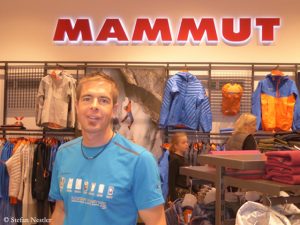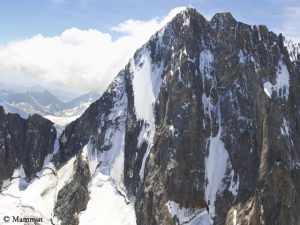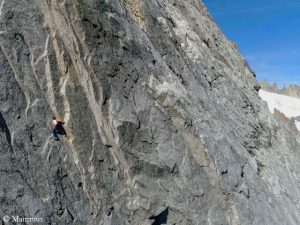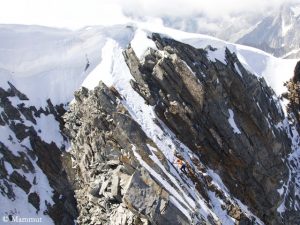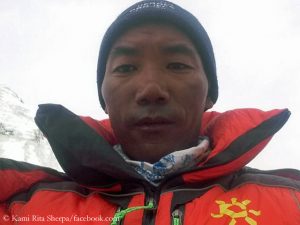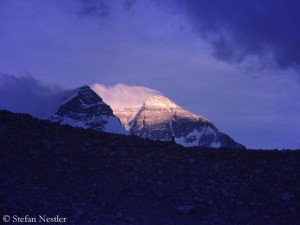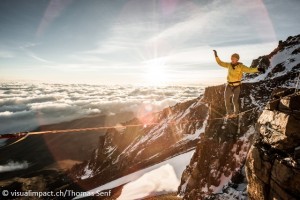Dani Arnold: “A little risk should be allowed”
Once again, he has almost sprinted up a wall. Last August, Swiss Dani Arnold climbed the Grandes Jorasses North Face solo and without rope in the new record time of 2:04 hours. In 1938, it had taken the first climbers (led by Italian Riccardo Cassin) three days to complete the route via the Walker Spur. Since 2015, the 34-year-old is also holding the speed record for climbing the North Face of the Matterhorn (1:46 hours). Dani had made his first bang in 2011 when he broke Ueli Steck’s record in the Eiger North Face by 20 minutes and reached the summit after 2:28 hours. Steck had regained the best time in 2015 (2:22 hours).
Dani Arnold is a mountain guide and lives with his wife Denise in the canton of Uri in the 4,000-person village of Bürglen, where more than 200 inhabitants (no joke, he confirmed it to me) bear the name Arnold. I met Dani in my hometown Cologne – before his appearance as the main speaker of the Cologne Alpine Day.
Dani, how do you like the name “Usain Bolt of the classical north faces in the Alps”?
I think it’s a bit exaggerated. I am certainly very fast, but there are many other very, very good climbers. I think it’s just not true that I’m the best.
But perhaps the fastest. After all, you hold the speed record on two of the three classic north faces in the Alps. When you climb so fast, do you sometimes get into a state of intoxication, like when running, when at some point a flow sets in and everything seems to go by itself?
Yes, there is such a feeling. I then feel free and light. If you, for example, climb the Waterfall Chimney, the Fragile Band and the Fragile Crack in the Eiger North Face, it usually takes you a lot of time. But when you’re doing it solo and at speed, you just follow one spot after the other. And then you really have the feeling that it’s fast.
Last summer you climbed the Walker Spur on the Grandes Jorasses in two hours four minutes, 17 minutes faster than the previous record holder Ueli Steck. You climbed completely without rope and other security equipment. How much risk is allowed from your point of view?
It’s not possible without risk, that’s quite clear. On the other hand, it was my goal to climb the Walker Spur without any security equipment. It was just to be the mountain and me. I first had to find out: Do I dare at all? Is it still safe? Then I decided upon this route. And I never had the feeling that I was taking a huge risk. I don’t think you can say in general that less equipment means higher risk.
How did you prepare yourself? Did you know every climbing move of this route?
The route is 1,200 meters long. I have the talent to remember places and climbing moves very well. I know, for example, how the grips look like at the Rebuffat-Corner, one of the difficult spots, and which hand I have to use on which grip. You also need a “rolling planning”, as I call it, and a lot of self-confidence.
You once said that there was a right to risk. What did you mean by that?
If you live for something, prepare seriously for it and then enter a danger zone, society will not accept that. I don’t think that’s right. After all, you don’t just approach these things negligently, out of ignorance or stupidity. If you really prepare yourself for something and take it seriously, you can also take a little risk, because it’s one hundred percent worth it.
Dealing with your speed records means also coming across the name Ueli Steck, because it was his records that you broke. He fell to his death at the age of 40 last year on Nuptse. Was that a warning, a reminder for you?
He did exactly the same as I do now. And of course you immediately think: Hej, that can also happen to you. I believe every accident – not only Ueli’s, but also those of other climbers – remains in the brain. That doesn’t mean that you are going a completely different way now. But I’m sure that I take not as much risk now as I did five or ten years ago.
When climbing at the highest level, there is always the danger of overtightening the screw one day. How do you protect from this?
The danger of going a step too far at some point is obvious. This also scares me a little, because of course I always try to reach the optimum and a little bit more. In order to counteract this, I go fishing, for example, or I simply spend time with friends and family, where we don’t talk about the subject of climbing at all. That helps me to get away from it a bit. Otherwise everything would be about climbing and also about this more, more, more. I have to have other thoughts and also to leave it well enough alone.
In the general public you are known above all because of your speed ascents. And yet you are a complete climber. For example, you are one of the first winter ascenders of Cerro Egger in Patagonia and you were also on expedition with the Huber brothers in the Karakoram. Does it bother you that you are often reduced to speed climbing in public?
It bothers me a bit. On the other hand, speed climbing allows me to make a living from climbing because there are enough lectures and sponsors. That’s why it’s important. When I do a 90-minute lecture on an evening, I use the fame for speed climbing to tell my heart stories, for example about mixed climbing in Scotland, these very, very difficult climbs.
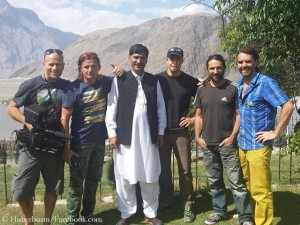
Dani Arnold (3rd from r.) in 2015 with Thomas and Alexander Huber, their Pakistani companion Rasool, Mario Walder and Seppi Dabringer (from right)
Will you go on big expeditions again in the next few years?
Definitely. In terms of difficulty and speed, things won’t go on this way forever. Then new stories on new mountains in unknown regions will come up. With the Huber brothers I really found two great guys with whom I really enjoy traveling. This is almost more important to me than being extremely strong. You have to have a good time together. And that’s what we have.
Would an eight-thousander also be interesting for you?
Certainly. Up to now I never felt the need to climb up there, but it’s developing slowly. I would like to experience what it feels like.
Do you have a dream destination, a mountain you absolutely still want to climb?
Actually not. The Eiger North Face, for example, wasn’t this one and only goal for me. I have many, many ideas. When it becomes more concrete in preparation, I focus on a mountain. And then it suddenly becomes my mountain, and there is no other one.
You have climbed the three big north faces of the Alps solo and at great speed, so a circle has closed – unless you want to regain the Eiger record. Are you going to tick off speed climbing now?
With the record in the North Face of the Grandes Jorasses, it’s a bit over. Most likely I won’t go back to the Eiger again. But I want to keep the whole topic open. I don’t really have a concrete speed project at the moment, but that can change suddenly for me. I think I haven’t quite finished that yet.
When will we see you again on a big expedition?
In winter I want to go ice climbing in Russia or China. I have never been there in high winter. I also want to meet the people living in these extremely cold regions. That fascinates me too. There are certainly cold fingers there! (laughs)
Can you climb a mountain just completely normal, without any ulterior motive on an extreme route?
Yes, there are those days when I have no ambitions and can just enjoy it. I still love this being outside.



